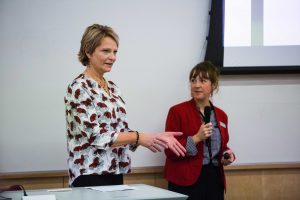Trigger Warning: This article deals with and mentions suicide, violence and loss of a child.
Tina and Mike Moerer started their memorial lecture series in 1998 after their son, Eric, took his own life in August 1997. The Moerers recall that while Eric had been in the preschool at the child development center on campus, the faculty in charge of the center made some observations about Eric. Mike Moerer said the faculty told them that, “he [Eric] is a bright kid and he’s going to be a challenge for you guys,” to which they replied “we got him” without thinking too much about the faculty’s concerns.
Mike Moerer remembers that if Eric underperformed in school, they thought it was because “he didn’t try hard enough,” not because of depression. They later learned that undiagnosed depression looks different in a teenage boy than adults. On the Friday before the first day of his junior year of high school, Eric hung himself.
After the tragedy, Tina Moerer recollected that Cheryl Wright, a friend of the Moerers, told them, “You guys need to do something with this. You can start a lecture series.” So they did, bringing in lecturers from the University of Utah and nationally, including one lecture session with Jim Webb, a well-known journalist, and his daughter. The Moerers also gave a lot of credit to Cheryl Wright who has helped them continue to host the series.
“We started with a panel down at the circle,” said Tina, “And ever since then, it’s been a series.” The lecture series held on Mar. 5 aimed to open up a dialogue about how depression and anxiety can manifest differently across individuals as well as to destigmatize depression.
Tina Moerer said that the ideal outcome of the series is for those in attendance to “gain some awareness” so that “they themselves will be able to impact others in their lives.”
The Moerers set up a fund to support the development of social and emotional needs of children through research on campus. In addition to contributions from Tina and Mike Moerer, several other individuals have designated additional money to the fund, mostly from family and friends of the Moerers. Tina also recognizes that “the university has been really supportive.”

(Photo by Matt Gubler | The Daily Utah Chronicle)
Mary Nickles, a news anchor from KUTV Channel 2 News, moderated the panel. According to Nickles, “we need to talk more about suicide and depression.” Nickles recalled a time when she covered a story about suicide that she offered not to run but that the family said she should in order to spread awareness. Nickles introduced each of the panelists and also gave the disclaimer to those in attendance that some information discussed during the event may be triggering.
Elisabeth Conradt, an assistant professor of psychology at the U, spoke about anxiety signs in children. Conradt said some “anxiety is normal in early childhood” and “is readily treatable” for young children. She describes some of the symptoms to look for as difficulties eating or sleeping, inconsolable fussiness or irritability, throwing wild, despairing tantrums, aggression, withdrawn behavior and/or flat affect, engaging in compulsive activities, difficulty playing with others and little or no communication. Conradt added that if you are concerned about your child, you should “talk with a pediatrician,” and can call Help Me Grow at 211 for more information or to visit www.helpmegrowutah.org.
Christina Lecluyse, a clinical social worker at the U Counseling Center, spoke on anxiety and depression in college. “Anxiety and depression are common things college students experience,” Lecluyse said, and we must “take into account each client’s personal background.” Lecluyse also recognized that “college is a challenging time for students” where “students often examine identity issues.” While the U is a “larger campus that can make it hard to find your personal identity,” it also means that “as a larger university there are more groups to join.”
Another commonality among college students is something called “imposterism,” which Lecluyse describes as students feeling like “I don’t really have what it takes to get here, but somehow I made it through.” The U Counseling Center is a resource that provides up to 12 individual sessions per year at no cost to each U student. Students can also attend group therapy an unlimited number of times per year. Lecluyse said that group therapy can be beneficial because it is “good to hear from people with similar concerns,” and they strive to make the sessions a place where students can feel comfortable and develop coping skills.
Philip Osteen, an associate professor of social work at the U, spoke about how men manage anxiety and depression. In a study measuring depressions that included self-reported questions about factors such as appetite and sleep habits, women showed higher rates of depression compared to men. According to Osteen, researchers hypothesized that the reason women score higher on these depression studies “may be an artifact of how we are describing depression.” This inspired a new study of depression in which levels of anger and irritation were measured, and men scored higher on rates of suicidal thoughts than women, indicating that higher expressions of anger were linked to a higher probability of experiencing thoughts about suicide. Osteen said that researchers “may be thinking of men’s mental health in a different way,” and added an issue may be that we are “seeing depression, poor mental health behavior, as normal.”

(Photo by Matt Gubler | The Daily Utah Chronicle)
Sonia Salari, an associate professor of family and consumer studies at the U, brought up suicide rates among older generations as well as murder-suicide rates. According to Salari, “suicide and family violence are linked” and sometimes suicide can be performed in a way that is meant to hurt others. Salari also said that media can sometimes cause “a violence contagion” by over-sensationalizing a story.
Utah’s suicide ranking is fourth in the nation, which is up 46 percent since 1999. Male suicide is more likely to occur later in later life than for women. Salari studied partner homicide/suicides in 728 intimate partners and found that young adults are primarily homicidal while older adults are primarily suicidally driven. Domestic violence was often found in a young adult relationship while not described as part of an older couple’s relationship. She added that murder-suicide “is definitely domestic violence.” “Mercy killings” and “joint suicides” were found to be rare. If you are seeking help against domestic violence, contact the Utah Domestic Violence Coalition at 800-897-5465.
Jeremy Christensen, Assistant Director at the Utah Division of Substance Abuse and Mental Health, spoke on legislation around suicide prevention that Rep. Steve Eliason, co-chair of the Utah Youth Suicide Prevention Task Force, is trying to pass. Christensen’s division is part of the Department of Human Services and they report directly to Gov. Gary Herbert.
When coming up with policies, Christensen said, “We think about it from every possible outlook.” One of the initiatives is a crisis line commission initiative to “address the macro level of legislation,” including a safeUT mobile app which is free and “allows for anonymous tips for any sort of violence or suicide.” Another policy goal for the task force is to be “thoughtful about how we restrict access to firearms.” Christensen added that Rep. Eliason is currently trying to pass more suicide prevention legislation through Congress.
Perry Renshaw, a professor of psychiatry at the U, discussed the relationship between depression and altitude. Renshaw discovered a correlation between low levels of serotonin and depression, as well as how serotonin levels impact levels of productivity in people at higher altitudes. The study found that depression levels decreased when individuals with low serotonin levels were administered serotonin. Renshaw said this research could help do a “better job of devising ways to help,” and mentioned that “the VA [Veteran’s Affairs Hospital] is actively involved in suicide prevention.“

(Photo by Matt Gubler | The Daily Utah Chronicle)
Robert Wesemann, executive director of National Alliance on Mental Illness (NAMI) Utah, spoke on tips and resources available for those contemplating suicide. He said the goal of their organization is “advocacy, education and support.” NAMI Utah offers courses for those experiencing mental illness and their families. “We’re having those conversations that we didn’t have before,” Wesemann said, and ”if we are willing to have the conversations, that’s curative in and of itself.”
“Don’t assume you know what’s going on,” Wesemann advised, “But give others the opportunity to tell you what is wrong.” He advocates that “we can listen and support people.”
Individuals can contact NAMI Utah by calling 801-323-9900. While this number is not a crisis hotline, it provides people at the other end of the line who are there to talk to you and listen.
k.collett@dailyutahchronicle.com
The post Recognizing Anxiety and Depression Across the Lifespan: Eric Moerer Memorial Lecture Series appeared first on Daily Utah Chronicle.
